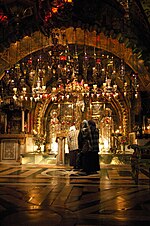Hayat Mosque
Asian mosque stubsIsraeli building and structure stubsMiddle Eastern building and structure stubsMosques in JerusalemPalestine stubs
The Hayat Mosque (Arabic: مسجد الحيات) is a small historical mosque located within the walls of the Old City of Jerusalem, in the Christian Quarter. It is one of the ancient mosques of the city, attributed to the Caliph Omar ibn al-Khattab. This mosque holds particular significance as it is situated next to the Church of the Holy Sepulchre to the east and is surrounded by shops. Its dimensions are 4x4 meters. It is named "Hayat," which is the Arabic plural of "snake," because, according to popular belief, it contains a talisman that is believed to neutralize the venom of the snakes that roam in Jerusalem and whose bites are potentially lethal.
Excerpt from the Wikipedia article Hayat Mosque (License: CC BY-SA 3.0, Authors).Hayat Mosque
Heil HaHandasa, Jerusalem Morasha
Geographical coordinates (GPS) Address Nearby Places Show on map
Geographical coordinates (GPS)
| Latitude | Longitude |
|---|---|
| N 31.77784 ° | E 35.22992 ° |
Address
העיר העתיקה
Heil HaHandasa
9511208 Jerusalem, Morasha
Jerusalem District, Israel
Open on Google Maps










